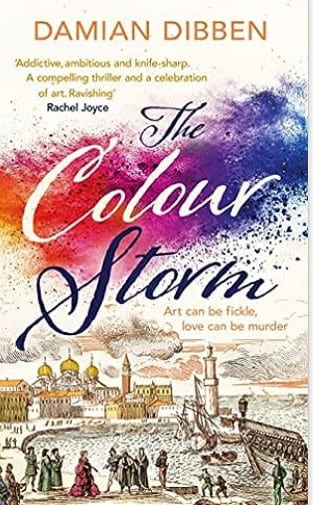We take colour for granted nowadays. We can have our cars in all sorts of colours and finishes, the walls of our houses and the plants in our gardens. There are books about the history of colour: I particularly enjoyed The Secret Lives of Colour by Kassia St Clair and these start to give us a glimpse into the world of passion about colour. Imagine it is 1510 and colours are rare and expensive. Ultramarine is a sort after colour but there are rumours of another colour found in mines far away that has never been used before. The Colour Storm is about how far one artist, Giorgione Barbarelli or Zorzo, would go to get this new colour, prince orient. Dibben has written a very interesting article about the introductions of new colours and how it can upset the balance when people make the colour their own even today. You can read it here.
Artsists start to appear in Venice as word of the new colour spreads as does Jakob and Sybille Fugger, one of the richest men in Europe, a miner and banker in whose mines the colour was found. Zorzo befriends Sybille and is allowed to paint her portrait and this is his entrée into the household which he hopes will gain him a contract to paint the inside of a new church and access to the prince orient.
The characters in the book are real ones, it is the story woven around them that is fictional. Zorzo falls in love with Sybille, that part is quite predictable, but the character Sybille is more interesting as is her relationship with her brother and husband. I wouldn’t say that colour is woven throughout the writing but it is definitely there when describing Sybille and her moods through her dress.
The phrase opens up Zorzo’s head again and panic tumbles out.
Sybille Fugger: silver gown, ivory face, carnelian lips, malachite room.
p233
There are other strands woven into the story such as the plague which was so prevalent during those times as well as a rumour about the ‘Inquisition’ being rolled out around the world, funded by a very rich person and backed by Rome.
You do get an insight into art during these times with Zorzo explaining where colours come from to Sybille and how he starts a painting – from the inside out to capture the person or from the outside in to try and capture the atmosphere and mood. And there are snippets where his passion for colour squeezes out.
‘Colours took me over. Completely. I volunteered for every job that would teach me more about them. I hurried around all the pharmacists and vendecolori of the city, comparing materials, inspecting, touching, smelling, turning everything to the light. Even the names of materials seemed to have this enchanted quality: porphyry, malachite, verdigris. Like names from mythology. I wondered how I’d managed to take it all for granted until then. An example: do you know there are about a hundred different yellows?’
p182
The book is marketed as a thriller and the role of the plague and a flood act as devices to heighten the sense of panic and need for speed. Everything is closing in and something has got to give.
I really enjoyed the art world side of this book, the relationship between Sybille and Zorzo less so. I didn’t feel it was a storm of colour, more showers – some of them quite heavy in places. For me, this book was a bit beige. I enjoyed the article about desire to own colour more.
